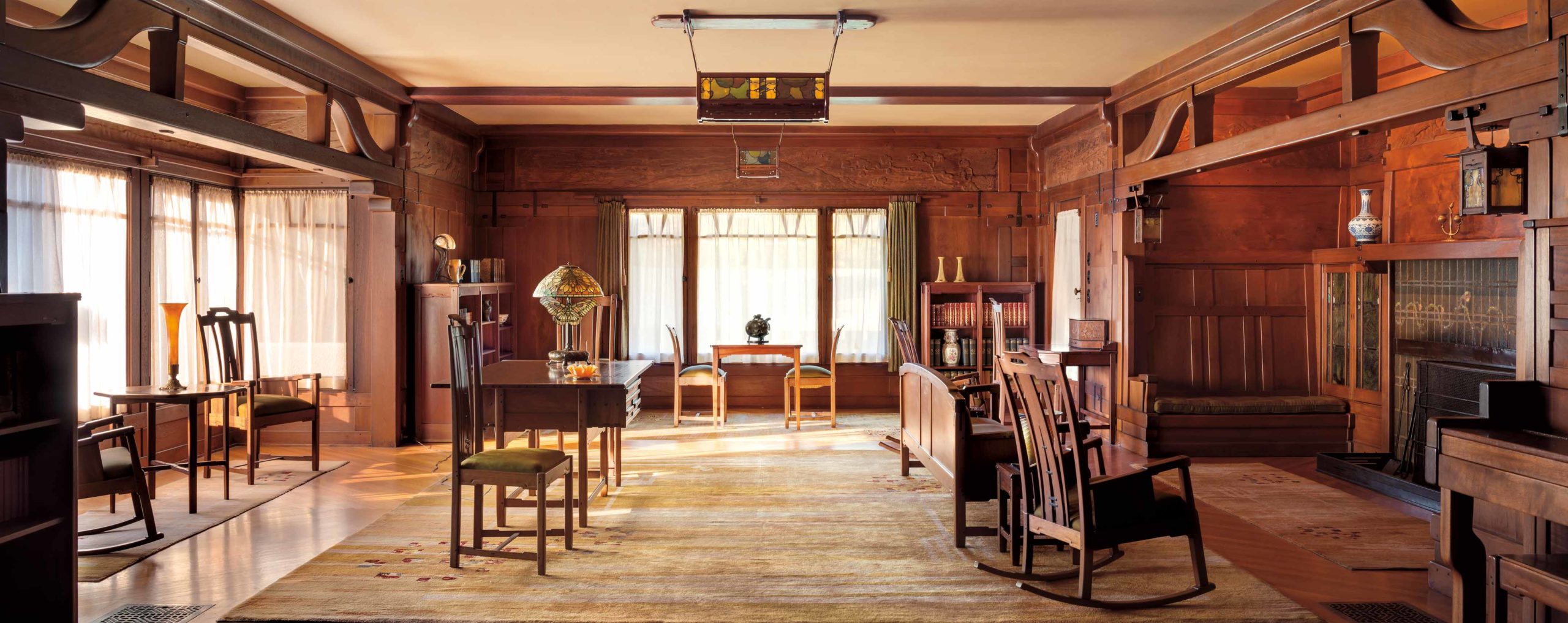
NW Exterior. The Gamble House.
Pasadena Craftsmanship
By David DeVoss
Every New Year’s Day America turns its attention to Pasadena, California to watch the Rose Parade and the Rose Bowl football game, which this year will showcase Penn State and the University of Southern California. The spectacles are marvelous advertisements for the city, which almost always enjoys winter sunshine while the rest of the country is freezing. What cameras tightly focused on the two events often miss, however, is Pasadena’s distinctive Craftsman architecture.
Craftsman is a term given to homes mostly built between 1905 and the early 1920s. The type of construction was the American expression of the Arts and Crafts movement that originated in England as a reaction against the ugliness of Industrial Revolution row houses. The movement emphasized handmade work, uniqueness and the use of natural materials.
In Pasadena these values live on in houses with exposed beams and rafters, a liberal use of stone and polished wood, built-in cabinetry and an aesthetic blending of interior and exterior space often expressed with shaded porches and terraces. Some of Pasadena’s most stylish Craftsman residences are owned by the California Institute of Technology, which uses them to house professors and distinguished research scientists.
Initially, the demand for Craftsman residences was driven by Midwest industrialists who came to Pasadena to enjoy the mild winter weather, a saloon-free environment favored by Presbyterians and the diversity of entertainment that featured talented actors and musicians who worked 16 miles away in a booming community called Hollywood. Two of the more prominent arrivals were David and Mary Gamble, Midwest Progressives from Cincinnati whose company, Procter & Gamble, became world famous with a product called Ivory soap. They moved to Pasadena at the dawn of the 20th Century and commissioned architects Charles and Henry Greene to build a Craftsman home on a promontory overlooking the Arroyo Seco, a thin riverbed that meanders down from the San Gabriel Mountains past the Rose Bowl and through Pasadena.
Located at 4 Westmoreland Place, the Gamble House is open to the public and is the logical first stop for those interested in understanding Craftsman architecture. Many visitors are struck by its dynamic expression of structure in the hundreds of beams and rafters that reach beyond the limits of its walls, porches, and eaves. The Gamble property is at the center of a 1.8-mile walking tour of Craftsman buildings that takes about 50 minutes. Pasadena Heritage, a local preservation organization, offers a free map of ten walking tours of neighborhoods like Prospect Park, Washington Square and Rose Villa that offer a variety of Craftsman styles

Living Room. The Gamble House
Craftsman architecture is experiencing a revival. Houseplans.com, an online seller of construction blueprints, reports that around 25% of the plans it sells are for Craftsman homes with contemporary refinements. Southern California’s best example of modern Craftsman architecture is Disney’s Grand Californian Hotel & Spa in Anaheim next to the California Adventure theme park.
On December 30, out-of-towners who come for the Rose Parade and football game can buy $20 tickets for two Architectural Legacy Tours offered by Pasadena Heritage. Offered at 10:30 a.m. and 1:30 p.m., the tours will visit the Hillcrest and South Orange Grove neighborhoods and be guided by Pasadena Heritage preservation director Jesse Lattig. He will point out the Craftsman mansions that are preserved and how they have inspired Craftsman motifs in newer Victorian and Mediterranean structures. To get more detailed information on meeting locations call (626) 441-6333 or visit www.pasadenaheritage.org.
David DeVoss is the editor and senior correspondent of the East-West News Service.

